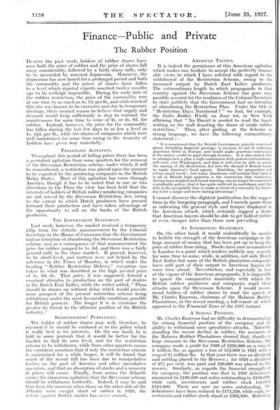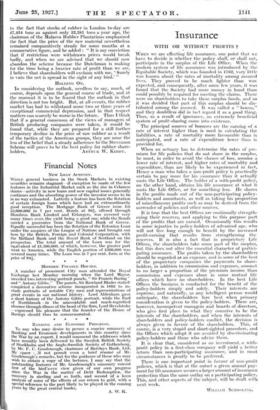Finance Public and Private The Rubber Position DURING the past
week, holders of rubber shares have seen both .the price of rubber and the price of shares fall away considerably, followed by a fairly sharp -rally, only to he succeeded by renewed: depression. Moreover, the depression has now lasted for a prolonged period and both the commodity and the prices of shares have fallen to a level which 'reputed experts asserted twelve months ago to be welinigh impossible. During the early date of the rubber restriction, the price of the commodity rose at one time to as much as 4s. 7d. per lb., and while much of this rise was known to be excessive and due to temporary shortage, there seemed reason to believe that supply and demand would keep sufficiently in step • to warrant the Maintenance for some time to come of 2s. or 2s. 6d. for rubber. Instead, however, the price for the commodity has fallen during the last few days to as low a level as Is. 41d. per lb., while the shares of companies which were well maintained for some time owing to the tenacity of holders have given way materially.
PROLONGED AGITATION.
Throughout this period of falling prices there has been persistent agitation from some quarters for the removal of the Stevenson Restriction scheme, under which, it will be remembered, a restriction was placed upon the amount to be exported by the producing companies in the British Malay States. Most of this agitation has come through America, though it has to be noted that in one or two directions in the Press the view has been held that the interests of holders of British rubber-producing companies are not served by the Stevenson Restriction Act, owing to the extent to which Dutch producers. have pressed forward their production and have taken advantage of the opportunity to sell on the backs of the British producers.
TILE GOVERNMENT STATEMENT.
Last week, however, the market received a temporary fillip from the definite announcement by the Colonial Secretary in the House of Commons that the Government had no intention of abandoning the Stevenson Restriction scheme, and as a consequence of that announcement the price for rubber jumped to Is. 6d. and there was a fairly general rally in the share market. It proved, however, to be short-lived, and matters were not helped by the reference in the Times of Monday, in which under the heading " Rubber Restriction Defects," exception was taken to what was described as the high pivotal price of Is. 9d.-2s. That price, it was suggested, formed a constant stimulus to production on the part of dealers in the Dutch East Indies, while the writer added, " Plans should be drawn up without delay which would provide some prospect of the present restriction scheme being withdrawn under the most favourable conditions possible for British growers. The longer it is in existence the greater its threat to the ultimate position of the British industry."
SHAREHOLDERS' PERPLEXITY.
The holder of rubber shares may well, therefore, be excused if he should be confused as to the policy whiCh is really best in his interests. On the one hand, he is told in some journals that it would be better for the Alarket to find its own level, and for the restriction scheme to be withdrawn, while from other quarters comes the confident assertion that if only the restriction scheme is maintained for a while longer, it will be found that much of the recent fall has been due to manipulative tactics on the part of America and other speculative operators, and that an absorption of stocks and a recovery in prices will ensue. Finally, from across the Atlantic comes the clamorous agitation that the Stevenson scheme should be withdrawn forthwith. Indeed, it may be said that from the moment when those on the other side of the Atlantic were caught short of rubber in 1925, the outcry against British tactics has-never ceased.
AMERICAN TACTICS.
It is indeed the persistence of this American agitation which makes one hesitate to accept the perfectly reason. able views to which I have referred with regard to the withdrawal of the Restriction Scheme, owing to the increased output by Dutch East Indies producers. The extraordinary length to which propaganda in that country against the Stevenson Scheme has gone may possibly account for the readiness of the Colonial Secretary to state publicly that the Government had no intention of abandoning the Restriction Plan. Under the title of " Restriction Days Numbered ? " we find, for example, the India Rubber World, on June 1st, in New York affirming that " No Daniel is needed to read the hand- writing on the wall denoting the doom of crude rubber restriction." Then, after girding at the Scheme in strong language, we have the following extraordinary statement :- " It is announced that the British Government, gravely concerned about dwindling financial prestige, is anxious to aid in collecting American debts in Europe, and would make generous concessions if the money could be paid through London. It is also stated that to arrangesuch a plan a high commission with powers extraordinary will soon visit Washington, and that it will even be able to assure the casting of the Restriction Act into the discard if British banks be made America's fiscal agents. Doubtless, the proposition will evince much merit ; but many Americans will surmise that back of it all in British high quarters is the conviction that restriction, having been weighed and found wanting, can no longer be considered a profitable policy, that it has quite outlived its usefulness, and that now is the acceptable time to make a virtue of a necessity by barter- ing it for a larger and more lasting advantage."
I cannot discover the slightest justification for the sugges- tions in the foregoing paragraph, and I merely quote them as indicating the general style and temper displayed in the American attack, which certainly suggest a desire that American buyers should be able to get hold of rubber at even cheaper rates than those now prevailing.
AN INTERESTING STATEMENT.
On the other hand, it would undoubtedly be unwise to belittle the strength of the American campaign or the large amount of money that has been put up to keep the price of rubber from rising. Stocks have now accumulated in London to a point which renders unlikely any scarcity for some time to come, while, in addition, not only Dutch East Indies but some of the British plantation companies have sold part of their output to American buyers for some time ahead. Nevertheless, and especially in face of the vigour of the American propaganda, it is impossible to ignore the comparative unanimity with which the British rubber producers and companies repel these attacks upon the Stevenson Scheme. I would recom- mend holders of rubber shares to read the speech of Mr. Charles Emerson, chairman of the Malacca Rubber Plantations, at the recent meeting, a full report of which appeared in the Financial News of the 15th instant. . .
A STRONG POSITION.
Mr. Charles Emerson had no difficulty in demonstrating the strong financial position of the company and its ability to withstand mere speculative attacks. Notwith- standing the recent decline in rubber, the accounts of the Malacca, Rubber Plantations showed that, thanks in large measure to the Stevenson Restriction Scheme, the company made a profit for 1926 of £228,000 on a crop of 5 million lbs. as against a loss of £15,000 in .1921 with a crop of 31 million lbs. In that year there was no dividend and nothing placed to the Reserve.; for 1926 a dividend of 271 per cent. was paid and £20,000 was placed to the reserve. Similarly, as regards the financial strength of the company, the position was that in 1921 debentures amounted to 2199;590 and notes outstanding to £150,000, while cash, investments and rubber stock totalled £124,000. There are now no notes outstanding, the debentures have been reduced to 2175,220, while cash, in- vestments and rubber stock stand at £505,390. Referring to the fact that stocks of rubber in London to-dai are 67,454 tons as against only 22,281 tons a year ago, the chairman of the Malacca Rubber Plantations emphasized the fact that the price of the raw material nevertheless remained comparatively steady for some months at a remunerative figure, and he added-: " It is my conviction that if restriction were withdrawn prices would break badly, and when we are advised that we should now abandon the scheme because the Dutchman is making for the time being a heavier rate of profit than we are, I believe that shareholders will exclaim with me, ' Surely in vain the net is spread in the sight of any bird.' "
HOLDING ON.
In considering the outlook, needless to say, much, of course, depends upon the general course of trade, and at the moment it is to be feared that the outlook in that direction is not too bright. But, at all events, the rubber market has had to withstand some two or three years of exceptional commercial depression, and in that respect matters can scarcely be worse in the future. Thus I think that if a general consensus of the views of managers of British producing companies were taken, it would be found that, while they are prepared for a still further temporary decline in the price of raw rubber as a result of the tactics of the American groups, they are none the less of the belief that a steady adherence to the Stevenson Scheme will prove to be the best policy for rubber share-















































 Previous page
Previous page